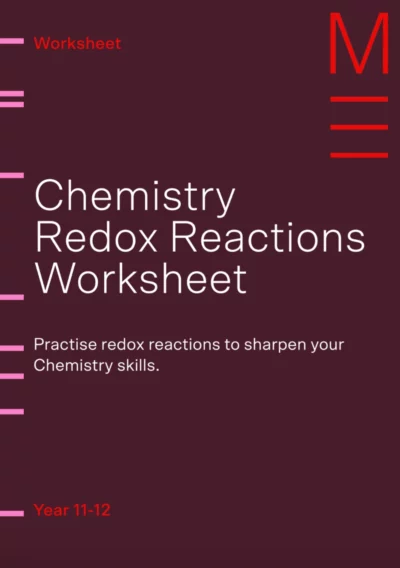Welcome to Matrix Education
To ensure we are showing you the most relevant content, please select your location below.
Select a year to see courses
Learn online or on-campus during the term or school holidays
Learn online or on-campus during the term or school holidays
Learn online or on-campus during the term or school holidays
Learn online or on-campus during the term or school holidays
Learn online or on-campus during the term or school holidays
Learn online or on-campus during the term or school holidays
Learn online or on-campus during the term or school holidays
Get HSC exam ready in just a week
Select a year to see available courses
Science guides to help you get ahead
Science guides to help you get ahead
Master Chemistry with these 5 essential redox reaction practice questions!

Join 75,893 students who already have a head start.
"*" indicates required fields
You might also like
Redox chemistry is one of the harder topics in VCE Chemistry and HSC Chemistry, but mastering it is key to doing well in your exams. Incorporating Chemistry redox reaction practice is a must if you want to confidently solve a wide range of redox questions. You need to do more than memorise—you need to understand how to apply the core concepts of oxidation and reduction to real-world examples, including some you’ve never seen before.
To help you master this topic, we’ve created 5 important redox questions you need to practice to succeed in VCE Chemistry and HSC Chemistry. Let’s get started and get you ready to ace your exams!
Before you download all 5 Chemistry redox reaction practice questions, check out the two sample questions below. It includes expert tips from the Matrix Chemistry team on how to answer redox questions properly.
Sharpen your skills with challenging redox problems and step-by-step explanations! Fill out your details below to get this resource emailed to you. "*" indicates required fields
Download your free Chemistry Redox Reactions Practice Worksheet

Download your free Chemistry Redox Reactions Practice Worksheet
Before diving into sample questions from our free redox practice worksheet, try these strategies to improve your Chemistry study.
Question 1
Consider the following redox reaction:
S2O32−(aq) + 4Br2(aq) + 5H2O(l) ⟶ 2SO42−(aq) + 8Br−(aq) + 10H+(aq)
Tips:
Question 2
Glucose is a potential source of fuel for fuel cells. The reaction for the anodic half-cell is
C6H12O6(aq) + 6H2O(l) ⟶ 6CO2(g) + 24H+(aq) + 24e− E° = −0.01 V
(a) Write the reduction equation that takes place at the cathodic half-cell. 1
(b) Calculate the standard potential of this fuel cell under standard conditions. 1
Tips:
Our free worksheet includes:
Fill out the form below and we’ll send the redox reactions practice worksheet straight to your inbox.
Sharpen your skills with challenging redox problems and step-by-step explanations! Fill out your details below to get this resource emailed to you. "*" indicates required fields
Download your free Chemistry Redox Reactions Practice Worksheet

Download your free Chemistry Redox Reactions Practice Worksheet
Written by Matrix Education
Matrix is Sydney's No.1 High School Tuition provider. Come read our blog regularly for study hacks, subject breakdowns, and all the other academic insights you need.© Matrix Education and www.matrix.edu.au, 2023. Unauthorised use and/or duplication of this material without express and written permission from this site’s author and/or owner is strictly prohibited. Excerpts and links may be used, provided that full and clear credit is given to Matrix Education and www.matrix.edu.au with appropriate and specific direction to the original content.